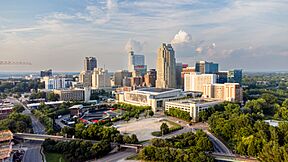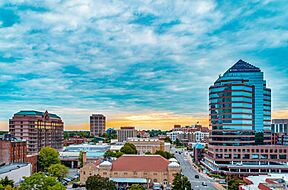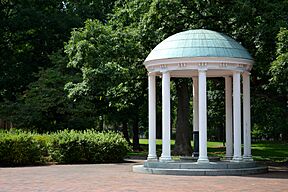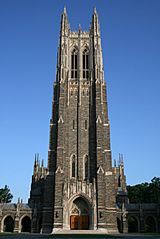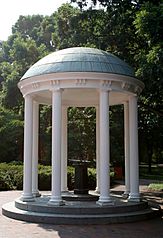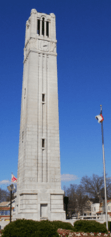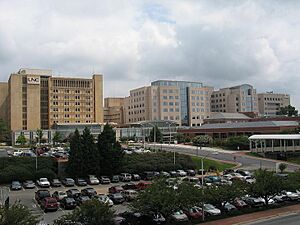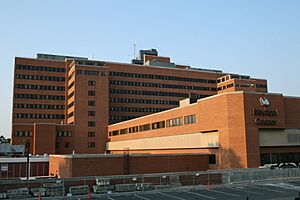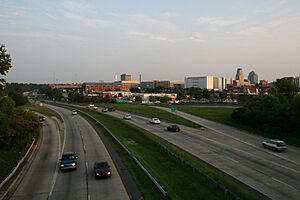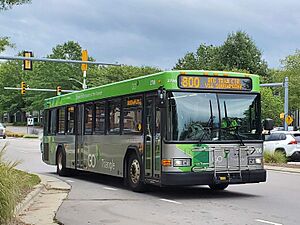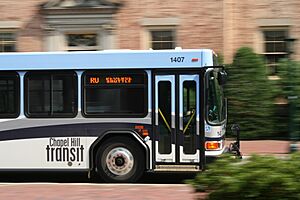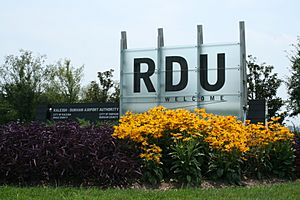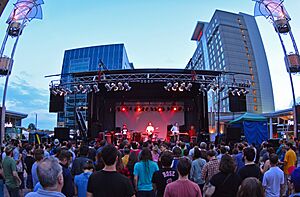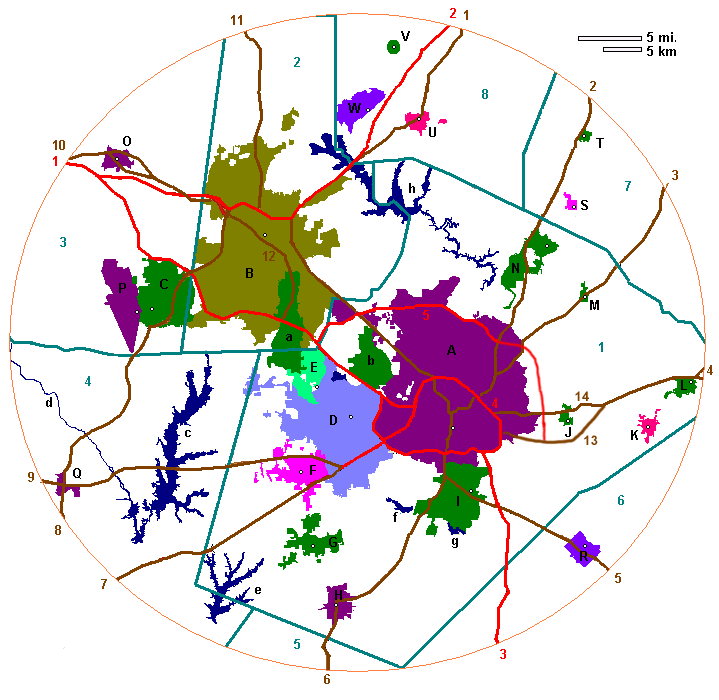Research Triangle facts for kids
Quick facts for kids
Research Triangle
|
|
|---|---|
|
Combined Statistical Area
|
|
|
|
|
| Country | |
| State | |
| Largest city | Raleigh |
| Other cities | Durham Chapel Hill Cary |
| Area | |
| • Total | 4,766 sq mi (12,340 km2) |
| Population
(2020)
|
|
| • Density | 442/sq mi (171/km2) |
| • CSA | 2,106,463 (32nd) |
| GDP | |
| • Raleigh–Durham–Cary (CSA) | $183.624 billion (2022) |
| • Raleigh (MSA) | $119.675 billion (2022) |
| • Durham-Chapel Hill (MSA) | $63.950 billion (2022) |
| Time zone | UTC−5 (EST) |
| • Summer (DST) | UTC−4 (EDT) |
| Area code(s) | 919, 984 |
The Research Triangle, often called The Triangle, is a large area in the Piedmont region of North Carolina. It gets its name from three important cities: Raleigh, Durham, and Chapel Hill. These cities are home to three major research universities: North Carolina State University, Duke University, and the University of North Carolina at Chapel Hill.
The "Triangle" name started in the 1950s. This was when Research Triangle Park was created between the three main cities. This park is the largest research park in the United States. Many high tech companies are located there.
The area is officially known as the Raleigh-Durham-Cary, NC Combined Statistical Area. It includes nine counties. In 2020, over 2.1 million people lived here. This makes it the second-largest combined statistical area in North Carolina.
Contents
What is the Research Triangle?
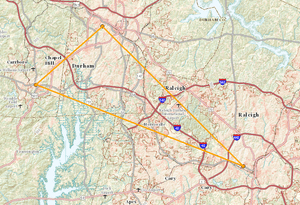
The Research Triangle is an area defined by its strong connections to research and technology. It includes several counties, but the most important ones are Wake, Durham, and Orange. These counties are where the three main universities are located.
The U.S. Office of Management and Budget (OMB) helps define these areas for statistics. The Raleigh-Durham-Cary area is made up of different smaller areas. These include the Raleigh-Cary area, the Durham-Chapel Hill area, and the Henderson area.
Major Cities in the Triangle
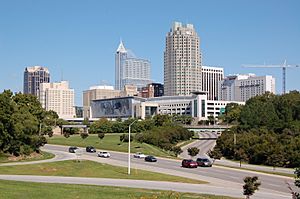
The Research Triangle includes nine counties. The main cities are Raleigh, Durham, and Chapel Hill. Other important cities and towns are Cary, Apex, and Wake Forest.
Raleigh is the capital of North Carolina and the largest city in the Triangle. Durham is the second-largest city. Chapel Hill is known for its university.
Here are some of the largest cities and towns in the Triangle area:
- Raleigh
- Durham
- Cary
- Chapel Hill
- Apex
- Wake Forest
- Holly Springs
- Fuquay-Varina
- Garner
- Morrisville
- Clayton
- Carrboro
- Knightdale
- Mebane
- Henderson
Education in the Triangle
The Research Triangle is famous for its excellent schools and universities.
Public Schools
Most public schools in the Triangle are part of county-wide systems. The Wake County Public School System is the largest in North Carolina. It serves cities like Raleigh and Cary. Other large school systems include Durham Public Schools and Johnston County Schools.
Universities and Colleges
The area is home to many colleges and universities. The three main ones are:
- North Carolina State University (in Raleigh)
- Duke University (in Durham)
- University of North Carolina at Chapel Hill (in Chapel Hill)
Other important schools include:
- Campbell University
- North Carolina Central University
- Meredith College
- Shaw University
- St. Augustine's College
- William Peace University
- Several community colleges like Wake Technical Community College
Sports in the Triangle
Sports are very popular in the Research Triangle, especially college sports.
College Sports
The three main universities in the Triangle are part of the Atlantic Coast Conference (ACC). Their teams are:
- Duke Blue Devils (Duke University)
- NC State Wolfpack (North Carolina State University)
- North Carolina Tar Heels (University of North Carolina at Chapel Hill)
These schools have strong rivalries, especially in basketball. Many students from local high schools go to these universities. This makes the rivalries even more exciting. The four ACC schools in North Carolina (Duke, UNC, NC State, and Wake Forest University) are sometimes called "Tobacco Road" in sports. All these teams are known for their high-quality play. Each of the Triangle-based universities has won at least two NCAA Basketball national championships.
Other colleges in the Triangle also have sports teams. These include North Carolina Central University, St. Augustine College, Shaw University, Campbell University, Meredith College, and William Peace University.
The Triangle will host the World University Summer Games in 2029.
Professional Sports
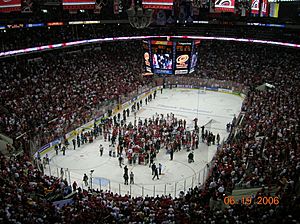
The Research Triangle has one major professional sports team: the Carolina Hurricanes of the National Hockey League. They play in Raleigh. The Hurricanes have been very successful, even winning a Stanley Cup.
The area also has popular minor league teams:
- The Durham Bulls (baseball, Triple-A affiliate of the Tampa Bay Rays)
- The Carolina Mudcats (baseball, Advanced-A affiliate of the Milwaukee Brewers)
- The North Carolina Courage (women's soccer, National Women's Soccer League)
- North Carolina FC (men's soccer, USL Championship)
Economy of the Triangle

The Research Triangle is a hub for high-technology and life science companies. Many well-known companies have offices or headquarters here.
Major Companies
Some of the big technology companies in the area include:
- IBM
- Lenovo
- SAS Institute
- Cisco Systems
- NetApp
- Red Hat
- Credit Suisse Group
The region is also a leader in life science companies. These companies work on things like medicine and biology. Some examples are:
Research Triangle Park and North Carolina State University's Centennial Campus are key places for new ideas and research. They help companies and universities work together.
The area did well during the economic downturn in the late 2000s. It was ranked as one of the strongest regions in North Carolina.
Major Hospitals and Medical Centers
The Research Triangle has many important hospitals and medical centers. These include:
- Hospitals of the Duke University Health System (like Duke University Medical Center)
- Hospitals of the UNC Health Care system (like North Carolina Memorial Hospital and Rex Hospital)
- Hospitals of the WakeMed system (like WakeMed Raleigh Campus)
- The Durham VA Medical Center
There are also several medical schools in the area, such as the Duke University School of Medicine and the University of North Carolina at Chapel Hill School of Medicine.
Transportation in the Triangle
Getting around the Research Triangle is made easier by a network of highways, public transit, and an international airport.
Highways

The Triangle is served by major interstate highways like I-40, I-85, and I-87. There are also loop highways like I-440 and I-540 around Raleigh.
Several U.S. Routes also run through the region. These include US 1, US 15, US 64, and US 70. Many of these are multi-lane highways.
North Carolina Highway 147 is a freeway that connects I-85 to other parts of the region. Some parts of it are toll roads, meaning you pay to use them.
Public Transit
Several public transportation systems serve the Triangle. They work together under the name GoTriangle.
- GoRaleigh serves Raleigh.
- GoDurham serves Durham.
- Chapel Hill Transit serves Chapel Hill.
- GoCary serves Cary.
GoTriangle also offers bus services that connect different parts of the region. They also help people find vanpool and rideshare options. There are plans to improve public transit, possibly with new rail systems.
Air Travel
Raleigh–Durham International Airport (RDU)
(IATA: RDU, ICAO: KRDU, FAA LID: RDU)
The main airport for the region is Raleigh–Durham International Airport (RDU). It is located near Morrisville in Wake County. RDU has flights to many places in the United States and some international destinations.
The airport has grown a lot over the years. It opened new terminals and runways to handle more passengers. In the past, airlines like American Airlines had hubs here. Today, Delta Air Lines considers RDU a "focus city."
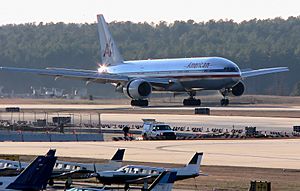
RDU continues to expand its services. As of June 2022, it offers international flights to places like Cancun, London, Montreal, Paris, Reykjavik, and Toronto.
Other Airports
Besides RDU, there are several smaller airports for private planes. These include:
- Triangle North Executive Airport in Louisburg
- Raleigh Exec in Sanford
- Johnston County Airport in Smithfield
- Harnett Regional Jetport in Erwin
- Person County Airport in Roxboro
- Siler City Municipal Airport in Siler City
There are also many private airfields and heliports (for helicopters) throughout the region.
Shopping in the Triangle
The Research Triangle offers many places to shop, from large malls to unique local centers.
Large Malls
- Triangle Town Center and Commons (Raleigh)
- The Streets at Southpoint (Durham)
- Crabtree Valley Mall (Raleigh)
Major Shopping Centers
- Crossroads Plaza (Cary)
- Village District (Raleigh)
- Carolina Premium Outlets (Smithfield)
- University Place (Chapel Hill)
- Carr Mill Mall (Carrboro)
- Tanger Outlet Center (Mebane)
- North Hills Mall & Plaza (Raleigh)
Entertainment and Culture
The Triangle has a lively arts and entertainment scene.
Festivals and Venues
- Film Festivals:
- Full Frame Documentary Film Festival (Durham)
- North Carolina Gay & Lesbian Film Festival (Durham)
- Performing Arts and Music Venues:
- Cat's Cradle (Carrboro)
- Coastal Credit Union Music Park (Raleigh)
- Red Hat Amphitheater (Raleigh)
- PNC Arena (Raleigh)
- Durham Performing Arts Center (Durham)
- Carolina Theatre (Durham)
- Music Festivals:
- Dreamville Festival (Raleigh)
- Hopscotch Music Festival (Raleigh)
- Moogfest (Durham)
- Shakori Hills Grassroots Festival (Pittsboro)
Museums to Explore
| Museums in the Research Triangle | ||||
|---|---|---|---|---|
| Museum name | Image | City | Type | Notes |
| 21c Museum Hotel | 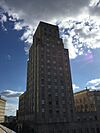 |
Durham | Art | |
| Ackland Art Museum |  |
Chapel Hill | Art | |
| Ayr Mount |  |
Hillsborough | History | |
| Contemporary Art Museum of Raleigh |  |
Raleigh | Art | |
| Duke Homestead | Durham | History | ||
| Kidzu Children's Museum | Chapel Hill | Children | ||
| Marbles Kids Museum |  |
Raleigh | Children | |
| Mordecai Mansion |  |
Raleigh | History | |
| Morehead Planetarium and Science Center |  |
Chapel Hill | Science | |
| Museum of Life and Science | Durham | Science | includes a small outdoor zoo | |
| North Carolina Museum of Art |  |
Raleigh | Art | |
| North Carolina Museum of History |  |
Raleigh | History | |
| North Carolina Museum of Natural Science |  |
Raleigh | Science | |
| North Carolina State Capitol |  |
Raleigh | History | |
| Nasher Museum of Art |  |
Durham | Art | |
Parks and Gardens
The Triangle has many beautiful parks and gardens for outdoor activities.
- JC Raulston Arboretum (Raleigh)
- Bond Park (Cary)
- Dorothea Dix Park (Raleigh)
- Sarah P. Duke Gardens (Durham)
- Durham Central Park (Durham)
- Falls Lake State Recreation Area (Raleigh)
- North Carolina Botanical Garden (Chapel Hill)
- Pullen Park (Raleigh)
- William B. Umstead State Park (Raleigh, Cary, Durham)
Lakes in the Region
Several lakes offer opportunities for recreation and enjoying nature.
- Lake Crabtree (Cary)
- Falls Lake (Raleigh)
- Hyco Lake (Roxboro)
- Jordan Lake (Durham)
- Lake Michie (Bahama)
- Shelley Lake (Raleigh)
Media in the Triangle
The Research Triangle is a major media market for television and radio.
Television
The area is part of the Raleigh–Durham–Fayetteville TV market. This means many TV stations serve the region.
- WUNC-TV (PBS)
- WRAL-TV (NBC)
- WTVD (ABC)
- WNCN (CBS)
- WLFL (The CW)
- WRAZ-TV (Fox)
Radio
The Triangle has many radio stations, offering different types of music and talk shows.
- 88.1 FM WKNC (College Radio)
- 89.3 FM WXYC (College Radio)
- 90.7 FM WNCU (NPR/Jazz)
- 91.5 FM WUNC (NPR)
- 93.3 FM WERO (CHR)
- 93.9 FM WNCB (Country)
- 94.7 FM WQDR-FM (Country)
- 97.5 FM WQOK (Hip Hop)
- 99.9 FM WCMC (Sports)
- 101.5 FM WRAL (Adult Contemporary)
- 105.1 FM WDCG (CHR)
- 106.1 FM WTKK (Talk)
- 620 AM WDNC (Sports)
- 680 AM WPTF (News, Talk & Sports)
Map of the Triangle
|
A – Raleigh |
1 – Wake County a – Research Triangle Park |
1 – I-40/I-85 1 – US 15 |
See also
 In Spanish: Área metropolitana de Raleigh-Cary para niños
In Spanish: Área metropolitana de Raleigh-Cary para niños


